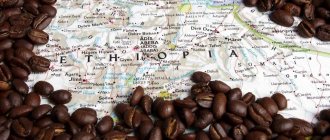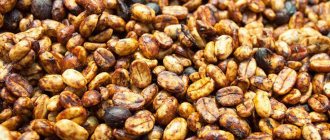Growing a coffee tree is a rather labor-intensive process. Much of the plantation work is often done by hand to produce high-quality beans with high flavor and aroma properties. Lovers of an exquisite invigorating drink will be interested in learning how coffee grows and where it is grown.
Definition of the concept “Coffee belt”
The coffee belt is an imaginary strip of surface on Earth located along the equator, the boundaries of which are removed from it at a distance of ±10 degrees to the north and south. The coffee belt includes, in whole or in part, more than 80 countries. Conventionally, it is divided into regions: Africa, Asia and Oceania, Central and South America.
The table shows the names of the top ten countries per region that are included in one or another zone of the coffee belt.
Table. Coffee Belt countries by ten in alphabetical order
| Africa | Asia and Oceania | Central America | South America |
| Ivory Coast | Vietnam | Haiti | Argentina |
| Zimbabwe | Hawaii | Guatemala | Bolivia |
| Yemen | Galapagos | Honduras | Brazil |
| Cameroon | India | Costa Rica | Venezuela |
| Kenya | Indonesia | Cuba | Guiana |
| Congo | Papua | Mexico | Colombia |
| Tanzania | Sumatra | Nicaragua | Paraguay |
| Uganda | Java | Puerto Rico | Peru |
| Ethiopia | Salvador | Ecuador | |
| ~20 more countries | ~10 more countries | ~10 more countries | ~10 more countries |
The Australian continent can be distinguished separately. The conditions for cultivating coffee there are quite harsh, but despite this, coffee is grown there too.
The core of coffee producing countries, however, is limited to a small amount that can be counted on the fingers of both hands. The following countries are considered to be the main producers of green coffee: Brazil, Colombia, Mexico, Guatemala - Central and South American part of the coffee belt, Uganda, Côte d'Ivoire, Ethiopia and Kenya - African belt, Indonesia, Vietnam, India - Asia and Oceania.
Is there good coffee in London, UK?
England, and London in particular, is associated with tea. Her Majesty's subjects tried coffee in the mid-1990s. At this time there was a boom in the opening of coffee shops, most of them concentrated in the East End, and they were opened by immigrants from Australia and New Zealand - famous coffee gourmets.
What to order:
- Flat white (The basis of this drink is espresso, which is prepared for 15, not 30 seconds, as usual. Steamed milk is added to it),
- cappuccino.
Travel along the coffee belt
If you take an imaginary journey along the coffee belt, then various pictures will appear before your eyes. These are mountains and plains, a humid and temperate climate, temperature changes (though in the positive zone). On the way you will meet Arabica and Robusta, Liberica and Excelsa trees. You will have the opportunity to communicate with people of all races: Caucasoid, Mongoloid and Negroid. And you will have to communicate in a variety of languages: Spanish, Portuguese, Indonesian, Hindi, Vietnamese, Ahmar, Swahili, French. And everywhere you will be offered their unique piece of the coffee belt.
Everywhere you will see how difficult it is to care for coffee plantations and manually harvest the next crop. Despite the natural landscape and climatic diversity, despite the differences in languages, faith, and way of life, people work on coffee farms everywhere for whom coffee is the basis of their way of life and world order. Often unfair and complex. That is life. Even in such an exotic corner of our planet as the coffee belt.
The figure schematically shows the habitat of coffee - Arabica and Robusta. This is a fairly limited space on Earth and in the temperature zone. The range of altitudes above sea level - from 200 m to 2 km - is comparable to the range of latitudes (coffee belt zone). The acceptable temperature range for normal ripening of coffee berries is from 15 to 25 degrees Celsius. The graph shows that for Robusta the growth conditions are less finicky than for Arabica.
It is easy to notice that Arabica does not overlap with Robusta. A border of about 300 meters wide separates the habitats of these plants. This also shows why Arabica is a more expensive variety of coffee bean. The fact is that this type of tree grows in the mountains or on hills. Therefore, one of the reasons for the higher price of Arabica than Robusta is the complexity of transporting finished coffee beans down to civilization.
Coffee: from import to export / Coffee in Rus' / Coffee tree in the apartment
The global economy is recovering from the pandemic. One sign of this is rising coffee prices. Exchange quotes for coffee futures collapsed in the first half of the year. People sat in self-isolation, slept as much as they wanted, and were in no hurry to go to work. The need for the invigorating alkaloid - caffeine - has dropped sharply. But as restrictions were lifted, the maelstrom of business life began to spin again. Coffee futures:
Chronic lack of sleep, sitting at work until late - all this increases the demand for a tonic drink. Now coffee prices have returned to the levels they were at at the end of last year, when the economy was still doing well. This means that most of the employees are back in action, life goes on. My program Economics on TV channel Crimea-24
More and more coffee is being produced around the world. Brazil is especially trying. The new agricultural year promises to be a record harvest in the history of mankind.
Unsold inventory is also high, but prices are still going up. This is influenced not only by the recovery in demand, but also by the unbridled operation of the dollar printing press. The money supply is growing faster than the volume of coffee in the world. Consequently, more and more dollars must be paid per kilogram of grains. This is one of the manifestations of inflation. For a long time, no one knew about the invigorating properties of coffee. The plant has always been close to people, but only in the Middle Ages did they think of making a drink from it. Most likely, there have been attempts to consume coffee before. People picked the berries, gnawed the grains, and saw that they were bitter. They spat it out and moved on, not having time to understand that it had a tonic effect. And even if they did understand, they didn’t pay attention to it. They didn't need it. In Rus', coffee has been known since the time of Peter the Great, and already in the 19th century it became an integral part of the diet of rich people. In Goncharov's novel Oblomov. The word “coffee” and its derivatives appear 48 times. “She grinned and again carefully began to turn the handle of the coffee mill, and her elbow described circles so quickly that Oblomov’s eyes dazzled.” 160 years have passed since the novel was published, and grinding beans using a manual coffee grinder is still a common practice. Not everyone has a coffee machine at home.
From tsarist times to this day, Russia has been increasing its coffee imports. Over the past 5 years, annual purchases have increased by 15%. This includes three product types: beans, ground coffee and instant. In the ranking of world importers, our country ranks 5th after the European Union, USA, Japan and the Philippines. Imports of grains – whole and crushed – are growing, while imports of soluble powders, on the contrary, are falling. It's an interesting dynamic. She has three reasons. The first is to improve drinking culture. Our fellow citizens are increasingly consuming natural products, rather than those sold in jars, poured with boiling water and stirred. There are more and more coffee gourmets. They value aroma, flavors, aftertaste and other properties. In instant coffee they are much worse than in natural coffee. Therefore, in Russia the demand for brewed coffee is growing. Moreover, professionally prepared. The second reason is the availability of coffee machines. Now they are in almost every office. This sharply reduces demand for 3-in-1 bags and other types of instant coffee. Moreover, it is more economical to buy grains than a jar of soluble powder. There is less human labor put into the grains, there is low added value, and they are cheaper. There is a third reason: Russia has its own factories for the production of instant coffee. Why buy abroad if you can make it at home. Raw materials are imported, processed and brought to marketable condition. As an example, I will give a plant of this type that recently appeared in the Leningrad region. It created 510 jobs. The volume of investment is 6.5 billion rubles. The demand for freeze-dried coffee is decreasing, but does not completely disappear, so entrepreneurs are occupying this niche. A higher level of development of the coffee industry is to start exporting. A striking example of this is the European Union. It is the world's largest importer of coffee. There are long-standing traditions of consumption and developed processing capacities. Therefore, it ranks first in the world in the export of roasted beans and ground coffee. And in second place - with a slight lag - is Switzerland. This country is considered separately because it is not part of the EU. In Europe, coffee trees are not grown. The industry operates on imported raw materials and advanced technologies for bringing them to marketable condition. The quality is so high that coffee from the Old World is sold all over the world, including in Crimean stores. To grow a coffee tree, you need a tropical climate. It is unlikely that global warming will reach such a scale that this would become possible in Russia on an industrial scale. But anyone can practice this at home, for themselves. The coffee tree not only takes root in the apartment, but also bears fruit. This can be an interesting experience for all exotic plant lovers.
Africa in the coffee belt
Africa is the historical homeland of coffee. Despite the difficult political, economic, and social conditions of life and work in this region, Africa supplies the best varieties of coffee. The African part of the coffee belt crosses more than 30 countries. This also includes the island of Madagascar. Each country is characterized by the characteristics of the collection and primary processing of coffee berries. Some countries are focused on supplying coffee to certain regions or cooperate with roasters on contract terms, while another part specializes in growing cheap robusta. We recommend starting to get acquainted with African coffee from Ethiopia and Kenya.
Life cycle
The first modest harvest appears on the branches 2 years after transplanting to an “adult plantation.” From this moment the life cycle of the coffee tree begins. Over the course of 3 years, the number of berries on the branches increases; over the next 2 years, “productivity” decreases.
Every 5 years the tree is pruned, leaving no more than 0.5 m in height - a year later a new trunk grows, and the cycle repeats again. The procedure cannot be done more than 6 times - the old plant will not bear fruit, so subsequent pruning loses its meaning.
The life cycle depends on the region in which the coffee is grown, but rarely exceeds 25-30 years. When a tree stops bearing fruit, it is replaced with a new one. To ensure high yields, hundreds of varieties are grown on one plantation, planting areas are changed, and the cycle of each plant is taken into account. To protect the coffee area from rain and direct sunlight, tall trees are planted next to it.
Asia-Pacific coffee region
The Asian-Pacific region includes, quite conditionally, the Australian continent. About two dozen countries cultivate coffee beans in this region of the Earth. Coffee from India is distinguished by the characteristics of trade winds and monsoon rains. The La Semuz company has a selection of inde plantation coffee, recommended for lovers of single-origin coffees. This part of the coffee belt produces rare varieties of coffee, in particular Kopi Luwak. Interesting from the point of view of coffee lovers and, at the same time, adherents of environmentally friendly products, are coffee beans from the island of Timor, located between the states of East Timor and Indonesia.
Venezuela
Although Venezuela is not such a large coffee exporter as Brazil, it is in no way inferior in quality. 300 thousand hectares of coffee plantations produce 60 thousand tons of coffee per year . Today, the authorities do not pay enough attention to the development of coffee plantations, but this country has good potential. The most famous Venezuelan coffee is Maracaibo . It received this name in honor of the port through which it is transported. The taste of coffee is not similar to other Latin American coffee, it has no sourness, the aroma is subtle and delicate .
Icelandic delicious coffee in Reykjavik
All 7 coffee shops in the Icelandic capital are thriving. They are full of guests, and the baristas are constantly preparing all kinds of coffee. The descendants of the Vikings never limited themselves to one cup.
When the weather warms up on the North Island, outdoor tables pop up outside coffee shop windows. Residents of Reykjavik soak up the sun while sipping their favorite drink. They can spend the whole day like this.
What to order: Latte or cappuccino
Is there good coffee in Seattle, USA?
The green mermaid that appears on all Starbucks cups comes from Seattle. The name is taken from the classic American novel “Moby Dick,” which tells the story of the difficult whaling industry.
Therefore, the first coffee shop that appeared in the port city in the mid-1970s was very opportune. Coffee was appreciated not only by sailors, but by the whole world.
What's the most delicious coffee you've ever drunk? What coffee tastes best to you? Share your experience on how to brew delicious coffee. I look forward to your comments.











